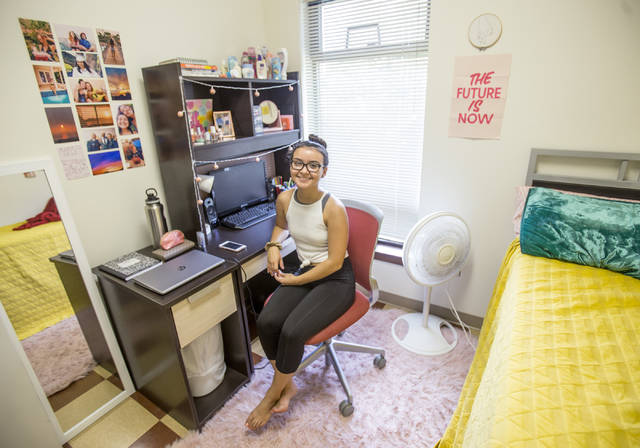Preliminary numbers show a dip in the occupancy rate for the University of Hawaii at Hilo’s newest dormitory, Hale ‘Alahonua, which has struggled to reach capacity since it opened in fall 2013.
Vice Chancellor for Student Affairs Farrah-Marie Gomes said Thursday that as of Sept. 14, Hale ‘Alahonua had 189 student residents, a 63 percent occupancy rate, which is down from last year’s 205 total, or 68 percent occupancy.
In Fall 2016, however, the dorm had 148 residents, a 49 percent occupancy rate.
“So if you were to put this on a bar graph, (you would) see there is no pattern,” said Gomes. “However, what happened between 2016 and 2017 is that we significantly reduced the rental rate in ‘Alahonua, which we believe led to that increase from 148 to 205.”
Part of the $28 million project was funded with a 30-year, $17 million revenue bond, to be paid back through money generated from housing fees, the Tribune-Herald previously reported.
But Hale ‘Alahonua, a 300-bed, suite-style dormitory, has struggled to fill all its beds since opening.
Occupancy was 57 percent that first year and dipped as low as 39 percent in 2015.
Housing officials last year introduced a plan to increase occupancy by lowering the cost to live in the dorm and to better market on-campus housing, the Tribune-Herald reported at that time.
The plan aimed to boost its occupancy by 90 additional students by the 2019-20 school year, to be met through incremental targets each year.
At the time those goals were set, Gomes said the university was projecting a conservative increase in enrollment, which hasn’t happened this year.
However, prior to last year, she said the percentage of the total student population living on campus was 19 percent, but both this year and last year that total is 21 percent.
That’s important, she said, because while enrollment has declined “the percentage of students that choose to live on campus has increased or remained stable from last year, basically, which tells us that the percentage of students that live in the dorms is increasing, despite declining enrollment.”
Gomes said the university is “still committed to the proposal” submitted to and approved by the UH Board of Regents in June 2017.
A decline in enrollment this semester was “unexpected and we will make adjustments to our plan because we are still committed to the outcomes we set forth in that plan.”
Because of the low occupancy in the past, the school previously had to subsidize its annual revenue bond payments used to help finance Hale ‘Alahonua’s construction with additional housing funds from its reserves.
However, Gomes said this year, “housing will cover the revenue bonds on its own. It is something we had started to plan for from the past two years, so even with the slight decline in occupancy, Housing is prepared to cover that (bond payment) amount for this year.”
UH-Hilo freshman Bethney De La Torre is one of the residents in Hale ‘Alahonua.
De La Torre said she wanted to live on campus because of the convenience.
“My family lives in Kona, so rather than driving every day, it would be easier to just live right here where school is,” she said from her room on Friday afternoon.
Plus, there’s the freedom dorm life offers.
“I wanted to get the full college dorm experience, if that makes sense,” said De La Torre.
So far, dorm life is good, although it “gets really hot,” she said. “That’s the only downside. I really like having my own room and I don’t have to share my space — and I still have my friend right there,” she said, gesturing to her suitemate’s room.
De La Torre said she chose Hale ‘Alahonua specifically because she didn’t want to share a room.
Cost was a concern, but was worth it because “it’s like you get what you pay for because you get your own space.”
Gomes said ventilation has been a problem in the hall.
Legislators, however, have appropriated a total of $6 million over two years to help address air conditioning in the dormitory.
According to interim Vice Chancellor for Administrative Affairs Kalei Rapoza, air conditioning improvements are anticipated to begin in July 2019.
The work includes air conditioning for 152 units and a lounge area, the design for which will be solar-powered “mini-package wall-mounted” air conditioning systems.
Construction is anticipated to be complete by June 2020.
This year, however, Gomes said there haven’t been any significant changes to the dormitory other than increasing Wi-Fi access points for better reception in the rooms and increasing resident-life programming, which is an ongoing focus.
“When students are living in the hall, you need to have programming outside of just having a place to live, which adds to the residential experience,” she said.
Additionally, Gomes said the university will welcome its new housing director next month.
“We’re looking forward to new perspectives, a fresh pair of eyes and continuing the work that we have cut out for us,” she said.
According to the UH-Hilo website, current housing rates, per semester and without dining plans, range from $1,772 to $3,377, depending on location and occupancy.
Email Stephanie Salmons at ssalmons@hawaiitribune-herald.com.






